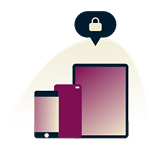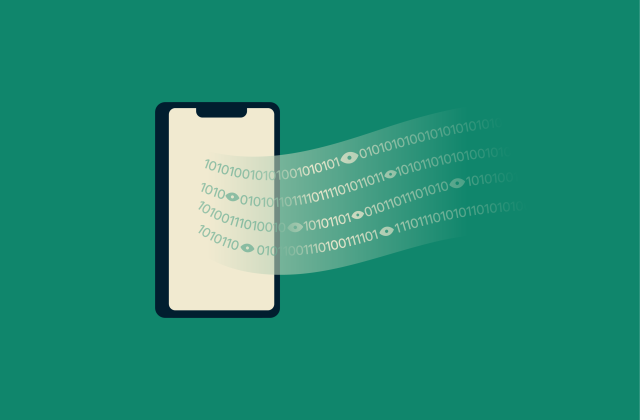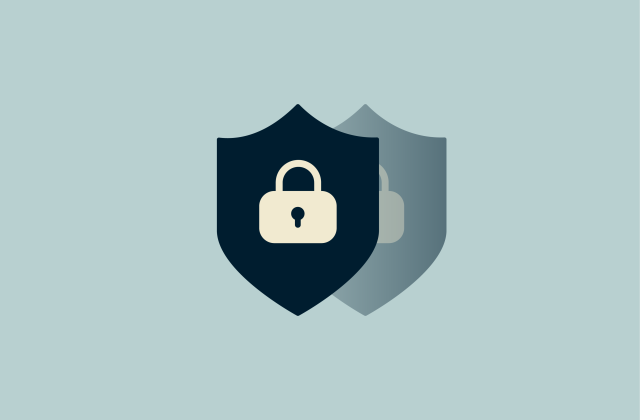What is identity theft, and how can you protect yourself?

Imagine waking up to find a credit card bill for things you never bought or getting a letter from the IRS about a tax return you didn’t file. That’s identity theft, and it happens when someone steals your personal information and uses it without your permission to gain access to money, credit, or services.
The damage can be serious, ranging from credit problems to legal complications. However, understanding how identity theft works is the first step toward stopping it early (or better, preventing it).
This guide will walk you through what identity theft really means, how it happens, and what you can do to stay ahead of it.
Please note: This information is for general educational purposes and not financial or legal advice.
Understanding identity theft
What does identity theft mean?

Identity theft happens when someone steals your personal or financial information and uses it without your permission. This can include your name, address, credit card number, Social Security number, or even health insurance ID.
Once they have this data, identity thieves may open new accounts, make purchases, or commit other types of identity fraud in your name. The consequences can be long-lasting and difficult to fix, especially if you don’t catch the theft early.
Why does identity theft matter?
Identity theft can have serious consequences, as a thief might steal funds from your bank account, damage your credit, or trigger medical bills for services you never received. In some cases, you may not notice anything wrong until you’re denied credit, get a call from a debt collector, or see a sudden drop in your credit score.
Fixing the damage identity theft causes can take months, and it often involves a long back-and-forth process with banks, credit bureaus, and other institutions.
Types of identity theft
Identity theft can take many forms. While financial fraud is the most common, criminals also target medical records, tax filings, and even the identities of children or deceased individuals. Here are the main types of identity theft you should know about:
- Financial identity theft: When someone uses your information to steal money or open credit accounts.
- Tax identity theft: Filing a tax return in your name to claim a refund or using your Social Security number to work under your identity.
- Medical identity theft: Using your details to receive healthcare services or submit insurance claims.
- Employment identity theft: Using your personal information to apply for jobs or pass background checks.
- Criminal identity theft: Using your information when caught or arrested by law enforcement.
- Synthetic identity theft: Creating a fake identity by combining your real stolen information with fabricated details.
- Child identity theft: Opening credit accounts or taking out loans using a minor’s data.
- Estate identity theft: Stealing the identity of someone who has passed away.
Identity theft statistics and trends
How common is identity theft?
Identity theft is more common than most people realize. In 2024 alone, the Federal Trade Commission received over 1.1 million reports of identity-related crime from across the U.S.
But numbers don’t tell the whole story. Many cases never get reported, and some victims don’t even realize their information was stolen until much later. That makes it hard to know how widespread the problem really is.
Most affected demographics and regions
Some states are affected more than others by identity theft. Florida had the highest rate in 2024, with 528 reports per 100,000 people, while South Dakota had the lowest, at just 94.
Beyond geography, certain demographic groups face heightened risk. People with significant assets across multiple accounts are common targets, since fraud can slip through the cracks unnoticed.
Children are also vulnerable, as their Social Security numbers aren’t likely to be actively used and monitored, meaning that misuse can go undetected for years. Finally, members of the military are at increased risk because of frequent relocations, deployments, and the need to share sensitive information with multiple agencies.
Industry sectors with the highest risk
Certain industries are more exposed to identity theft due to the type and volume of personal information they handle. These include:
- Financial services: Banks, credit unions, and payment platforms store sensitive data like account numbers and Social Security details, making them frequent targets for fraud and account takeovers.
- Healthcare: Medical providers hold rich identity data, including insurance records, prescriptions, and treatment history. Medical identity theft can lead to false claims or treatment under someone else’s name.
- Retail and e-commerce: Online and physical stores collect payment info and personal addresses. If systems aren’t secure, these become easy entry points for credit card fraud.
- Education: Schools and universities manage large databases of student and staff records. Student loan fraud and misuse of minors' information are common risks.
- Government and public sector: These entities process tax records, benefits, and IDs, making them targets for crimes like tax fraud and benefit scams.
Year-over-year growth in reported cases
In 2024, identity theft reports to the FTC rose by 9.5% compared to 2023, reaching over 1.1 million cases. The most common form involved credit card misuse.
Recent data from the Identity Theft Resource Center also shows major growth in more complex types of fraud over the past year, including:
- A 754% increase in account takeovers on tech platforms
- A 148% rise in impersonation scams
- A 600% surge in stolen birth certificate reports

Why identity theft is on the rise
Identity theft is constantly adapting. As people rely more on digital tools to manage their lives, criminals are finding new ways to take advantage. From public records and data leaks to social media and smart devices, there is more personal information to access and misuse than ever before.
The role of technology and online exposure
Technology makes life easier, but it also makes it easier for identity thieves to reach you. From your phone, you can check your bank, open doors, or control your home, all without leaving the couch. But each of those actions can expose personal data if security isn’t tight.
The more services we use online, the more chances criminals have to find weak points.
Social media, apps, and even smart home devices can give away information that helps attackers build a profile.
Data economy and black market demand
Your personal information is constantly moving through apps, websites, and services. It’s collected, stored, and sometimes shared or sold as part of everyday business. But once that data is out there, it becomes harder to control.
If it ends up in the wrong place after a breach or a scam, it can appear for sale on the dark web. Names, Social Security numbers, addresses, and even medical records can be bought cheaply. This widespread availability makes it easier for criminals to misuse that data in repeated identity theft attempts.
ExpressVPN’s Identity Defender tools, available to eligible U.S. customers, include ID Alerts, which monitor the dark web for your info, as well as tracking your SSN and watching for physical address changes.
How automation and AI enable large-scale fraud
Criminals are using artificial intelligence and automation to carry out identity fraud on a larger scale than was possible before. AI-driven phishing tools can craft emails and text messages that look highly convincing and are tailored to individual victims, making it easier to trick people into sharing sensitive information.
Deepfake audio and video are also being used to bypass biometric verification and impersonate trusted voices, adding another layer of risk for both individuals and organizations. Automation also enables more efficient credential-stuffing attacks, where bots test many thousands of stolen usernames and passwords across different sites in seconds.
Synthetic identities can also be created at scale by combining fragments of real and fake data, allowing criminals to open new accounts or access credit.
These methods make attacks faster, more scalable, and harder to detect. Even as businesses adopt advanced security controls, attackers leverage machine learning to probe systems for weaknesses and try to work around these defenses.
How identity theft happens
Identity theft can start in various ways, but the goal is always the same: to get your personal data and use it without your permission.
Common attack methods used by identity thieves
Identity thieves use a wide range of methods, some digital and some physical, to steal personal information and commit fraud.

Physical theft
Identity theft can begin with a physical theft, like a stolen wallet. In some cases, thieves might engage in “dumpster diving,” where they go through your trash hoping to find sensitive documents that are still readable. This is why it’s best to shred anything sensitive before disposing of it.
Phishing and spoofing
Phishing and identity spoofing go hand in hand. Phishing is the scam tactic: attackers send fake emails, texts, or messages that look like they’re from a trusted source like a bank or delivery service. The goal is to trick you into handing over sensitive info like passwords, Social Security numbers, or credit card details.
Identity spoofing is the technique: it’s when an attacker disguises their identity by falsifying information, such as making an email look like it came from a real domain (email spoofing), altering caller ID (phone spoofing), or masking an IP address. It’s used to make phishing attacks more convincing.
Skimming
Some identity thieves use physical devices attached to ATMs or card readers to steal data from the magnetic strip of your card. This method, known as skimming, lets them access your financial information without ever taking the card itself. It's a tactic that doesn’t rely on hacking but still gives direct access to your accounts.
Data breaches
Cybercriminals exploit vulnerabilities in company systems to carry out data breaches. When that happens, personal records like bank details, Social Security numbers, and tax information can be stolen in bulk. Once in the wrong hands, that data can be reused, sold on the dark web, or combined with other leaks to commit identity fraud.
Public Wi-Fi and unsecured networks
Connecting to public Wi-Fi in places like cafés, airports, or hotels might feel convenient, but if the network isn’t secure, it can expose your personal data. Some identity thieves use these open networks to intercept what others are doing online, such as capturing passwords, personal messages, or financial details. This is known as a man-in-the-middle attack.
Attackers might also create fake “evil twin” networks that look legitimate, tricking people into logging in. Once your information is entered, it may already be compromised. A VPN like ExpressVPN encrypts your internet connection, making it much harder for attackers on public networks to intercept your data or track your activity.
Social engineering tactics
Identity theft doesn’t always start with a technical hack; it often begins by manipulating people directly. Phishing emails, text messages, or phone calls may impersonate trusted institutions to trick victims into revealing sensitive information.
In more hands-on schemes, attackers might engage in pretexting: posing as a landlord, utility worker, or tech support agent, or attending open houses to search for unattended documents. These scams succeed not through technical know-how, but by exploiting human trust and timing.
How personal data is exploited after the attack
When personal data is leaked or stolen, it doesn’t always get used right away. Sometimes, it’s stored, combined with other leaked information, and organized into more complete profiles. That gives scammers more options and time to plan.
Leaked details like names, addresses, birthdates, or Social Security numbers can help fraudsters impersonate someone, open fake accounts, or apply for credit. The more data they collect, the easier it becomes to make the attack look legitimate. Even if the first breach doesn’t lead to fraud, the information can be reused later in more targeted and damaging ways.
Early warning signs of identity theft
Identity theft can go unnoticed for a long time, unless you spot the red flags early. Some of the most common signs of identity theft include:
- Suspicious account activity or billing errors: Unexplained charges on your accounts or medical bills you didn’t incur may signal misuse of your information.
- Unexpected notifications from financial institutions: Alerts from banks, the IRS, or companies you don’t recognize could mean your data was exposed or used fraudulently.
- Credit denial for unknown reasons: Being turned down for credit or insurance without any past issues could indicate that your records have been altered.
How to respond if you suspect identity theft
If you think someone has stolen your personal information, take action quickly. Here are a few first steps you can take to limit the damage:
- Monitor accounts and freeze your credit: Check your bank and credit card activity. If something doesn’t look right, report it. You can also request a credit freeze or fraud alert from the three major credit bureaus to help block further use of your data.
- Strengthen your account security immediately: Change your passwords, especially on financial and email accounts, and don’t reuse the same ones. Reusing passwords makes you vulnerable to credential stuffing attacks, where criminals use stolen logins from one site to break into others. You should also lock up sensitive documents at home and never carry things like your Social Security card in your wallet.
- Report fraud to the appropriate institutions: Notify the FTC at IdentityTheft.gov. Filing an identity theft report can help you dispute charges and recover your accounts. Some victims also choose to file a report with their local police department, especially if documentation is required by creditors or insurers.
Protecting yourself from identity theft
You can’t stop data leaks, but you can reduce your risk of being targeted. Here are a few simple habits that help protect your identity:

- Safe browsing and email habits: Be careful where you click. Avoid pop-ups, spam emails, and any links that don’t come from a source you trust. And don’t assume that a website is safe just because it uses HTTPS; most phishing sites have valid SSL certificates. Learn how to really tell if a website is safe before entering personal information.
- Credit monitoring and alerts: Keep an eye on your accounts. Check your bank and credit card statements regularly, and request the free credit reports you’re entitled to from each of the three bureaus to catch any unfamiliar activity. For extra peace of mind, tools like ExpressVPN Identity Defender, available for users in the U.S., include a credit monitoring scanner that tracks changes to your credit file and sends alerts, so you can respond quickly to any suspicious activity without checking manually.
- Multi-factor authentication and password best practices: Use strong, unique passwords for each account and enable multi-factor authentication where possible. This adds an extra layer of protection if someone tries to access your accounts. A password manager like ExpressVPN Keys can help generate and store secure passwords, making it easier to maintain strong credentials across all your devices.
- Identity theft protection services: Consider tools that monitor your personal information for signs of misuse and help you detect, prevent, and recover from fraud. ExpressVPN Identity Defender offers a full suite of protection, including dark web monitoring, credit and financial alerts, and data broker removals, so you can catch threats early and take action fast. Identity Defender is available for U.S. users.
Learn more about whether identity theft insurance is worth it.
FAQ: Common questions about identity theft
What causes identity theft?
Identity theft happens when someone gains access to your personal data without permission. This can occur through stolen wallets, phishing emails, fake websites, public Wi-Fi, data breaches, and more. Thieves may also collect personal details from social media or physical mail.
How serious is ID theft?
Identity theft can lead to serious financial loss, damaged credit, denied loans, and even legal trouble if someone commits a crime using your identity. The effects are often long-lasting and may take months or even years to resolve. Victims may also face emotional stress and challenges proving their innocence when fraud goes unnoticed for too long.
Can identity theft be prevented completely?
Not really. While you can take essential steps to lower your risk, like using secure passwords, avoiding suspicious links, and monitoring your accounts, there’s no guaranteed way to prevent identity theft entirely. Data breaches and leaks beyond your control can still expose your information, which is why dark web monitoring is an important defense.
What information do identity thieves target most?
Identity thieves commonly seek data like Social Security numbers, driver’s license and passport info, and financial account details. This information can be used to access existing accounts, create fake identities, or commit fraud in your name.
Is identity theft a crime, and how is it punished?
Yes, identity theft is a crime under U.S. federal and state laws. Penalties can include fines and prison time, depending on the severity of the offense and the type of fraud committed. Law enforcement agencies, including the FTC and the IRS, investigate and pursue these cases.
Take the first step to protect yourself online. Try ExpressVPN risk-free.
Get ExpressVPN



















